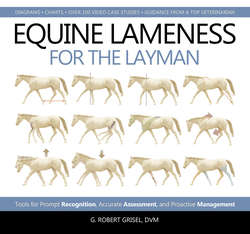Читать книгу Equine Lameness for the Layman - G. Robert Grisel DVM - Страница 7
На сайте Литреса книга снята с продажи.
Introduction
ОглавлениеThe words, “This would be a lot easier if the horse could just tell us where it hurts!” have been muttered many times over the course of my veterinary career. The horse’s inability to verbally disclose the reasons for inadequate performance seems to imply that we, as equine professionals, have to be exceptionally clever with regard to deciphering the details of any related problem. Of course, the savvy veterinarian understands that the inherent “mystery” of equine lameness may also figure into a successful career.
Ironically, my many years as an equine practitioner have taught me that lame horses actually do tell us where it hurts. Of course, it took me a while to realize that horses went to the trouble to impart this information. And like many of us, I initially lacked the innate ability to visually “tune into” the lame horse, primarily because I was accustomed to listening with my ears instead of my eyes.
Indeed, the lame horse actually goes to great lengths to tell us that there is a problem. Most will even reveal the likely cause to anyone who is willing to pay a little extra attention. As we’ll see, horses utilize a form of “sign language” that they convey by altering the movement of their body and limbs. Those of us who learn to assimilate this form of nonverbal communication will become effective observers of equine lameness. Of course this demands that we first explore the interplay between motion and meaning.
The key to informative visual assessment lies in our ability to recognize patterns of movement. The horse repeats both normal and abnormal actions with each stride, thereby affording us the opportunity to develop and confirm our impressions over time. Pattern recognition will be the basic technique that we utilize during our study of the lame horse throughout the course of this book. This skill requires that we develop the ability to “listen” with our eyes and refrain from overthinking what we see. Fortunately for us, lameness recognition can indeed be learned.1
The primary objective of this book is to provide a structured and systematic approach to visually interpreting physical gestures made by the lame horse. These gestures come in a variety of visual forms, each of which retains a unique appearance. Fortunately for us, horses are quite expressive in their movement and tend to adhere to explicit patterns of gait that can be readily distinguished from one another. Horses of different breeds that do different things in different parts of the world, for instance, will usually display a specific form of lameness in the same way. The following chapters provide you with the tools necessary to identify common visual markers displayed by lame horses. We will also discuss when and where to look for these markers so as to glean the maximum amount of clinical information possible from your assessment. Acquiring basic knowledge of the common forms of lameness (Section III), pertinent equine anatomy (Section IV), and common visual markers (Section V) will help as you navigate the examination process (detailed in Section VI).
As you might expect, some of the ensuing content is quite advanced; several visual markers are very subtle and their interpretation somewhat sophisticated. Notwithstanding, it will help you to consider the material solely within the context of how it will affect what you see with your eyes. Video commentaries are provided along the way to help you identify and characterize various patterns of movement, one feature at a time. Each commentary can be accessed directly on your smartphone by scanning the QR (“Quick Response”) code located within that aspect of the book’s narrative pertaining to the topic of interest. (There is also an index of video links and codes beginning on page 229.) Once you learn to recognize distinct patterns of movement, you’ll be able to distinguish between numerous forms of equine lameness.
Naturally, the intention is not to create a world in which horse owners are diagnosing lameness. A diagnosis is what we pay the veterinarian to provide for us. Rather, the information in this guidebook should be used to develop an appreciation and basic understanding of equine locomotion with the goal of being better prepared to recognize, classify, and rate your horse’s lameness when it occurs. The benefits associated with acquiring these basic skills will also be highlighted. Assessment will become especially fun and productive once you’ve learned to differentiate the nature and severity of what you’re seeing. You’ll be surprised at how much of the horse’s language you’re able to interpret. You’ll also be surprised to discover how much your horse has been trying to convey all of these years.
The information compiled in this book is based on personal experience. Observations have been developed and refined while performing approximately 30 equine lameness examinations per week over a 25-year period. Albeit the techniques described herein relate to horses, they could also be implemented to assist in the visual assessment of other quadrupeds and humans. Of course, they are most helpful when evaluating animals that can’t speak (verbally) to us.
